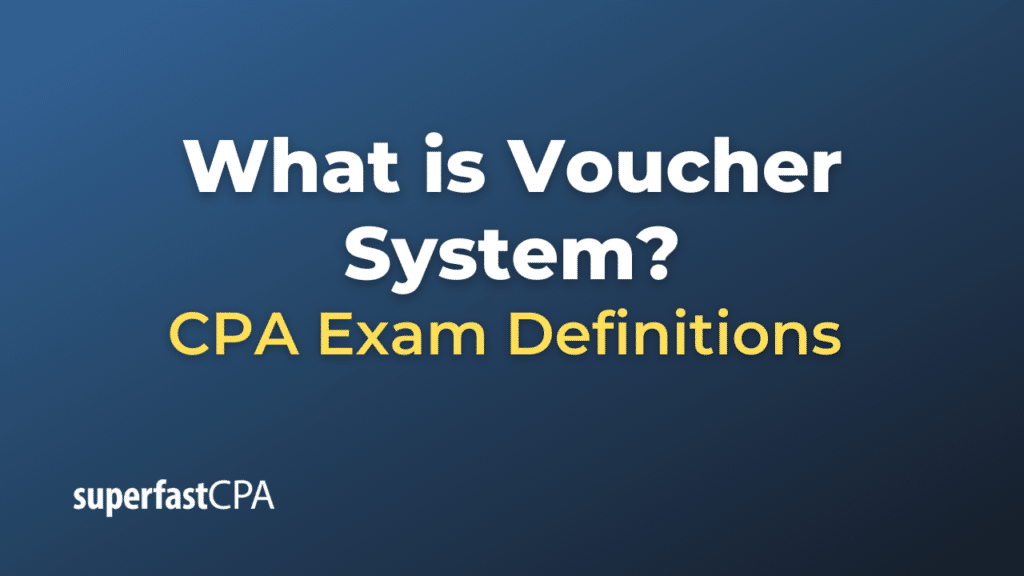Voucher System
A voucher system is an internal financial control mechanism used to process and control expenditures in an organization. The system involves the use of vouchers, which are documents that serve as proof for transactions and authorizations for payments. The voucher system is often used in accounts payable to manage and process vendor payments but can also be used for other types of transactions like employee reimbursements.
In a voucher system, every step of the transaction process— from the initiation of a purchase to the authorization and the final payment — is documented and verified before a payment is made. This creates a paper trail that adds a layer of security and accountability, thereby reducing the risk of fraud, errors, or unauthorized transactions.
Typical Steps in a Voucher System
- Initiation: A department or individual identifies a need for goods or services and fills out a purchase requisition.
- Approval: The requisition is reviewed and approved by the authorized personnel, often a manager or department head.
- Purchase Order: A purchase order (PO) is issued to the vendor, detailing the goods or services to be purchased, price, and other terms.
- Receiving Goods/Services: Once the goods or services are received, a receiving report is created, confirming the quantity and quality of the goods or services.
- Invoice: The vendor sends an invoice for the delivered goods or services.
- Voucher Creation: A voucher is created to summarize the transaction. The voucher will include details like vendor information, invoice details, goods received, and the total amount due. It will also have attached supporting documents like the PO, receiving report, and invoice.
- Verification and Authorization: The voucher is then reviewed for accuracy. It usually passes through several layers of approval, such as a manager, accounts payable clerk, or financial controller, who verify that the transaction is accurate and authorized.
- Payment: Once the voucher is approved, payment is scheduled according to the agreed payment terms.
- Recording and Archiving: Finally, the approved voucher is recorded in the accounting system, and all supporting documents are archived for future reference or audits.
Benefits of a Voucher System
- Accountability: Multiple layers of verification and approval make it difficult for fraudulent or erroneous payments to pass through.
- Audit Trail: A well-maintained voucher system provides a clear, organized paper trail for internal reviews or external audits.
- Budget Control: The system allows for better budget oversight by requiring approval at various stages.
- Operational Efficiency: Standardized procedures mean that the payment processes are consistent and efficient, making it easier to train staff and maintain quality control.
By establishing a strong voucher system, an organization can significantly reduce the risk of overpayments, duplicate payments, fraudulent payments, and other types of financial errors.
Example of Voucher System
Let’s look at a fictional example to illustrate how a voucher system works from start to finish in a corporate setting.
Company:
- Company Name: WebSolutions Inc.
- Industry: Software Development
- Department: IT Department
Scenario:
The IT Department needs to purchase five new high-performance laptops for the development team.
Steps:
- Initiation: John, the IT manager, identifies the need for new laptops. He fills out a purchase requisition form detailing the specifications, quantity, and the estimated cost.
- Approval: The purchase requisition is sent to Sarah, the Department Head, who reviews the request and approves it.
- Purchase Order (PO): John then creates a Purchase Order, which specifies the type of laptops, quantity, and agreed price. The PO is sent to the chosen vendor, TechWorld.
- Receiving Goods: When the laptops arrive, Mark, an IT technician, inspects the laptops to confirm they match the specifications in the PO. He then prepares a receiving report.
- Invoice: TechWorld sends an invoice for the five laptops to WebSolutions Inc.
- Voucher Creation: Emily, an Accounts Payable clerk, creates a payment voucher. This voucher includes:
- Vendor: TechWorld
- Invoice Number and Date
- Description: Five high-performance laptops
- Total Amount: $10,000
- Payment Terms: Net 30
- Attachments: Copy of PO, receiving report, and vendor invoice
- Initial Verification: Emily’s signature
- Verification and Authorization: The voucher is reviewed by Sarah (Department Head) and then by Tom (Financial Controller). Both sign off on the voucher, confirming it is accurate and ready for payment.
- Payment: After all approvals, Emily schedules the payment. A check for $10,000 is issued to TechWorld, and it is mailed before the Net 30 payment deadline.
- Recording and Archiving: The transaction and all its documents (PO, voucher, receiving report, check copy) are recorded in the accounting software for future reference and auditing.
Importance:
- The purchase requisition and PO ensure that the purchase is necessary and within budget.
- The receiving report confirms that the goods received match the purchase order.
- The voucher system involves several layers of approval, minimizing the risk of fraudulent or erroneous payments.
- The entire transaction, from initiation to payment, is documented and archived, providing a clear audit trail.
This is a simplified example, but it demonstrates the checks and balances put in place by a voucher system to ensure that expenditures are legitimate, authorized, and properly recorded.













